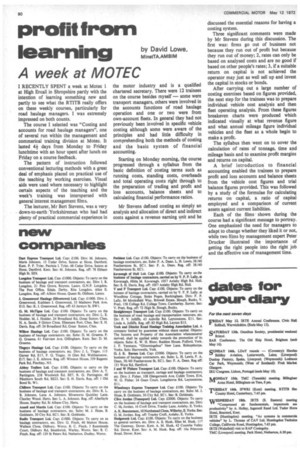profit from
Page 96

If you've noticed an error in this article please click here to report it so we can fix it.
learning by David Lowe
MInstTA AMBIM
A week at MOTEC
I RECENTLY SPENT a week at Motec 1 at High Ercall in Shropshire partly with the intention of learning something new and partly to see what the RT1TB really offers on these weekly courses, particularly for road haulage managers. 1 was extremely impressed on both counts.
The course I selected was "Costing and accounts for road haulage managers", one of several run within the management and commerical training division at Motec. It lasted 44 days from Monday to Friday lunchtime with an hour spent after lunch on Friday on a course feedback.
The pattern of instruction followed conventional lecturing methods with a great deal of emphasis placed on practical use of the teaching by working exercises. Visual aids were used where necessary to highlight certain aspects of the teaching and the week's training was interspersed with general interest management films, The lecturer, Mr Bert Stevens, was a very down-to-earth Yorkshireman who had had plenty of practical commercial experience in the motor industry and is a qualified chartered secretary. There were 12 trainees on the course besides myself some were transport managers, others were involved in the accounts functions of road haulage operation and one or two were from own-account fleets. In general they had not previously been involved in specific vehicle costing although some were aware of the principles and had little difficulty in comprehending both the methods of costing and the basic system of financial accounting.
Starting on Monday morning, the course progressed through a syllabus from the basic definition of costing terms such as running costs, standing costs, overheads and total operating costs right through to the preparation of trading and profit and loss accounts, balance sheets and to calculating financial performance ratios.
Mr Stevens defined costing as simply an analysis and allocation of direct and indirect costs against a revenue earning unit and he discussed the essential reasons for having a costing system.
Three significant comments were made by Mr Stevens during this discussion. The first was: firms go out of business not because they run out of profit but because they run out of money; 2, rates can only be based on analysed costs and are no good if based on other people's rates; 3, if a suitable return on capital is not achieved the operator may just as well sell up and invest the capital in stocks or bonds.
After carrying out a large number of costing exercises based on figures provided, the next step for the trainees was to prepare individual vehicle cost analysis and then fleet operating analysis. From these figures breakeven charts were produced which indicated visually at what revenue figure and what annual mileage figure individual vehicles and the fleet as a whole begin to make a profit.
The syllabus then went on to cover the calculation of rates of tonnage, time and mileage basis and to examine profit margins and returns on capital.
A brief introduction to financial accounting enabled the trainees to prepare profit and loss accounts and balance sheets from the vehicle cost figures and trial balance figures provided. This was followed by a study of the formulae for calculating returns on capital, a ratio of capital employed and a comparison of current assets against current liabilities.
Each of the films shown during the course had a significant message to portray. One emphasized the need for managers to adapt to change whether they liked it or not, while two films by management expert Peter Drucker illustrated the importance of getting the right people into the right job and the effective use of management time.
















































































































































































































